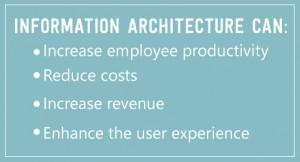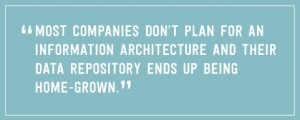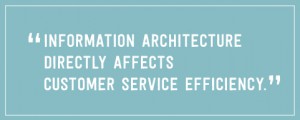In the world of collaboration portals, intranets and digital workplaces, the phrase Information Architecture (IA) can sometimes get used haphazardly and the true definition and more importantly…the real value in IA gets lost in obscurity. People have heard the term and likely have used it in conversation…but the definition can differ considerably depending on who you ask. So what is Information Architecture really and why should I care? There are a few definitions given to us by the pioneers of IA (Louis Rosenfeld, Peter Morville, Jesse James Garrett, etc.) that get used in hardcore IA circles. In my previous post, Information Architecture – What is it? I introduced a definition that is unique in the literal sense, but can be largely credited to these pioneers.
Information Architecture: Organizing information and creating solutions (browse and search) to facilitate intuitive access to content.
Why talk about IA? What value can it bring your business? The answer for both questions is: IA can increase employee productivity, reduce costs, increase revenue and enhance the user experience. Because of these reasons you are wise not to ignore it, but conversely, it makes good business sense to learn what Information Architecture really is and the benefits it can bring to your organization.
Here are three examples of where a deliberate approach to IA increases productivity, reduces cost, increases revenue or enhances the user experience. Two of the three examples come from first-hand knowledge, as I was helping develop the Information Architectures for these projects. The third example is just a great example of why IA shouldn’t be ignored due to its direct impact on productivity, customer satisfaction and revenue.
Example 1: I was working on a large enterprise project for Company A to fix two problems: Problem 1: right size a content database that was wayyyyyy beyond its suggested Microsoft capacity size limitation. Problem 2: create an Information Architecture for approximately 30 teams (these 30 teams represented over 1,000 information workers who were working on a multi-year global project for Company A) whose existing team sites spun out of control.
A little bit of context is necessary at this point. The company implemented SharePoint, spun up team sites for each of the teams on the project and created an approach whereby each team was given a SharePoint site with two libraries: a private library (only the team could see the contents of this library) and a public library (anyone on the project could see this information). One of the teams I worked with had over 2,000 nested folders in just one of these libraries and over 14,000 documents throughout these folders. Ouch! Finding the right document at the right time to complete task A or to give accurate information at a meeting was difficult and took time. This company was now in a situation where they were routinely paying skilled information workers and managers to “look for information” instead of paying them to do what they were hired for. There are numerous studies done on this type of inefficient dollar spend due to poor IA or “no IA”. The amount of money estimated that companies are spending is staggering.
The IA implemented for this organization consisted of spending time with each of the 30 teams gathering detailed information about the information they create, consume and collaborate on. Once we had this information, we were able to organize team sites using content types, lists, libraries and metadata to allow teams to put their content into SharePoint in a meaningful and organized fashion and in doing so, paved the way for intuitive access to content when users need to find information. The net result was that the user experience improved exponentially, employee productivity went up and the money that Company A was spending paying skilled employees to look for information was reduced significantly.
Example 2: One of the companies I worked with had 10-15 year old home grown document repository that required careful management due to ISO certification. The repository consisted of Microsoft Word documents that had “buttons” that linked to other Microsoft Word documents that were filled with “buttons”. The buttons served as category and sub-category headings that provided a navigational structure of sorts. After clicking through X number of buttons you would get to your document. If you’re smiling…remember this is the norm…most companies don’t plan an Information Architecture and their data repository ends up being home-grown and with most home-grown content repositories…there are numerous challenges as time goes on.
Moving this information into SharePoint will allow this company to build a powerful navigation (browse) structure that is highly flexible and intuitive. It will also give them the ability to use SharePoint Search (SharePoint 2013) which offers vast improvements over earlier versions of SharePoint and over their existing solution. On this project I spent the lion’s share of my time helping the organization create a taxonomy of terms that would allow users to access content quickly through navigation (including customized navigation pages) and search. Based on our term taxonomy and the application of these terms within SharePoint, a user will be able to pull up any document using the keywords most familiar to users. A strategic IA will allow manufacturing employees and information workers to quickly find the necessary documents, consume the right information and get back to the tasks they are being paid to perform. It will also allow reporting for ISO audits to be done much more easily than before. By tagging documents with the right metadata associated with ISO requirements, pulling back the right documents for ISO audits will be fast, easy and flexible. A deliberately planned IA will also support workflows and other advanced functionality this organization may pursue down the road.
Example 3: A Customer Service Call Center. If Customer Joe has to wait past his personal patience threshold while Customer Service rep Jane looks for the information that helps answer Joe’s question, this reflects badly on the Company. If this happens to Joe more than once, the company in question risks losing Joe as a customer. This is an IA no-brainer. Here efficiency directly impacts customer satisfaction and customer satisfaction directly impacts the company’s bottom line. And guess what impacts customer service efficiency? Yep, you guessed it…the amount of coffee the customer service rep drank to keep them going throughout the day. Ok, real answer, you guessed it…Information Architecture directly affects customer service efficiency and the linkage to revenue in this scenario is too close to ignore.
In closing, Information Architecture is a specific discipline within web based information systems design. The benefits of implementing a strategic Information Architecture can include: increasing productivity, reducing costs, increasing revenue and enhancing the user experience. Next week, in the last article in this series, I’ll share some fundamental concepts and tactics for developing an Information Architecture.





